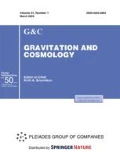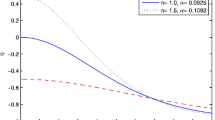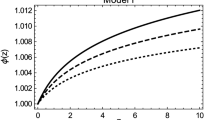Abstract
The dynamics of the Brans-Dicke (BD) cosmology in the Einstein frame is studied. We implement phase-space analysis in order to investigate the role of initial conditions and model parameters in the evolution of the universe. The phase plane algorithm and stability of the model are considered in the Einstein Frame where the cosmological background is described in Λ-Cold Dark Matter (ΛCDM) and is supplemented by a Jordan-Fierz-Brans-Dicke field. Our results show: (1) The model parameter α (the coupling strength of the BD scalar field to matter sources) in the Einstein frame plays an important role in the model stability whereas the initial conditions significantly affect the cosmic dynamics. (2) Using type Ia SNIa data, we fit the parameters of the model with observation and show that the current value of the effective equation of state (EoS) parameter is within the range supported by observations. (3) The phase space analysis implies that the universe approaches an attractor in the near future.
Similar content being viewed by others
References
J. Dunkley et al., “Five-year Wilkinson Microwave Anisotropy Probe (WMAP) observations: Bayesian estimation of CMB polarizaztion maps,” Astrophys. J. 701, 1804 (2009).
E. Komatsu et al., “CMB anisotropies at second order III: Bispectrum from products of the first-order perturbations,” Astrophys. J. Suppl. 180, 330 (2009).
S. Perlmutter et al., “Measurements of Omega and Lambda from 42 high-redshift supernovae,” Astrophys. J. 517, 565 (1999).
A. G. Riess et al., “Observational evidence from Supernovae for an accelerating Universe and a cosmological constant,” Astron. J. 116, 1009 (1998).
J. L. Tonry et al., “Cosmological results from high-z Supernovae,” Astrophys. J. 594, 1 (2003).
A. G. Riess et al., “Type Ia Supernova discoveries at z > 1 from the Hubble Space Telescope: Evidence for past deceleration and constraints on dark energy evolution,” Astrophys. J. 607, 665 (2004).
D. J. Eisenstein et al., “Detection of the baryon acoustic peak in the large-scale correlation function of SDSS luminous red galaxies,” Astrophys. J. 633, 560 (2005).
C. Blake et al., “A primer on hierarchical galaxy formation: the semi-analytical approach,” Mon. Not. Roy. Astron. Soc. 365, 255 (2006).
T. Clifton, P. G. Ferreira, A. Padilla, and C. Skordis, “Modified gravity and cosmology,” Phys. Rep. 513, 1 (2012); arXiv:1106. 2476.
K. Koyama, “Cosmological tests of modified gravity,” Rep. Prog. Phys. 79, 046902 (2016); arXiv: 1504. 04623.
C. Brans and R. H. Dicke, “Mach’s principle and a relativistic theory of gravitation,” Phys. Rev. 124, 925 (1961).
P. Jordan, Schwerkaft und Weltall. A New Strategy for Solving Two Cosmological Constant Problems in Hadron Physics. (Vieweg, Braunschweig, 1955).
A. A. Starobinsky and J. Yokoyama, “Density fluctuations in Brans-Dicke inflation,” gr-qc/9502002.
S. Tsujikawa, “Modified gravity models of dark energy,” Lect. Notes Phys. 800, 99 (2010); arXiv: 1101. 0191.
L. Qiang, Y. Ma, M. Han, and D. Yu, “Fivedimensional Brans-Dicke theory and cosmic acceleration,” Phys. Rev. D 71, 061501(R) (2005).
L. Qiang, Y. Gong, Y. Ma, and X. Chen, “Fixed points in interacting dark energymodels,” Phys. Lett. B 681, 210 (2009); arXiv: 0910. 1885.
E. Babichev and D. Langlois, “Relativistic stars in f(R) and scalar-tensor theories,” Phys. Rev. D 81, 124051 (2010); arXiv: 0911. 1297.
C. H. Brans, “The roots of scalar-tensor theory: An approximate history,” gr-qc/0506063.
A. Coc, K. A. Olive, J. P. Uzan, and E. Vangioni, “QCD effects in cosmology,” arXiv: 0811. 1845.
G. Esposito-Farèse and D. Polarski, “Scalar-tensor gravity in an accelerating universe,” Phys. Rev. D 63, 063504 (2001).
J. A. R. Cembranos and A. de la Cruz Dombriz, “A f(R) gravity without cosmological constant,” Phys. Rev. D 88, 123507 (2013).
A. Hojjati, L. Pogosian, and G.-B. Zhao, “Testing gravity with CAMB and CosmoMC,” JCAP 1108, 005 (2011).
K. N. Ananda, S. Carloni, and P. K. S. Dunsby, “A characteristic signature of fourth order gravity,” Class. Quantum Grav. 26, 235018 (2009); arXiv: 0812. 2028.
A. de la Cruz-Dombriz, A. Dobado, and A. L. Maroto, Phys. Rev. Lett. 103, 179001 (2009).
A. Abebe, A. de la Cruz-Dombriz, and P. K. S. Dunsby, “Large scale structure constraints for a class of f(R) theories of gravity,” arXiv: 1304. 3462.
A. G. Riess et al., “A cosmic vector for dark energy,” Astrophys. J. 607, 665 (2004).
S. Cole et al., “A primer on hierarchical galaxy formation: the semi-analytical approach,” Mon. Not. R. Astron. Soc. 362, 505 (2005).
R. Yan et al., “Fitting the integrated spectral energy distributions of galaxies,” Mon. Not. R. Astron. Soc. 398, 735 (2009).
R. Amanullah et al., “Spectra and light curves of six Type Ia Supernovae at 0. 511 < z < 1. 12 and the Union2 Compilation,” arXiv: 1004. 1711.
Y.-F. Cai et al., “Direct probe of dark energy through gravitational dark energy,” Phys. Rept, in press, doi10. 1016/j. physrep. 2010. 04. 001 (2010).
T. Gonzalez, G. Leon, and I. Quiros, “Emergent Universe with exotic matter,” Class. Quantum Grav. 23, 165 (2006).
S. Nojiri, S. D. Odintsov, and S. Jhingan, Phys. Lett. B 562, 147 (2003).
R. R. Caldwell, M. Kamionkowski, and N. N. Weinberg, Phys. Rev. Lett. 91, 071301 (2003).
Y.-F. Cai and J. Wang, Class. Quantum Grav. 25, 165014 (2008).
J. Q. Xia et al., Int. J. Mod. Phys. D17, 1229 (2009).
E. J. Copeland, M. Sami, and S. Tsujikawa, Int. J. Mod. Phys. D 15, 1753 (2006).
P. A. R. Ade et al., “Planck 2015 results-xiii. Cosmological parameters,” Astron. Astroph. 594, A13 (2016).
Alejandro Aviles et al., “Holographic dark matter and dark energy with second order invariant,” Phys. Rev. D 84, 103520 (2011).
Orest Hrycyna and Marek Szydlowski, “Cosmological dynamics with nonminimally coupled scalar field and a constant potential function,” JCAP 12, 016 (2013).
G. Papagiannopoulos, John D. Barrow, S. Basilakos, A. Giacomini, and A. Paliathanasis, “Dynamical symmetries in Brans-Dicke cosmology,” Phys. Rev. D 95, 024021 (2017).
A. Salehi, H. Farajollahi, and S. Aryamanesh, Grav. Cosmol. 24, 292 (2018).
G. Esposito-Farese and D. Polarski, “Scalar-tensor gravity in an accelerating universe,” Phys. Rev. D 63, 063504 (2001).
Author information
Authors and Affiliations
Corresponding author
Rights and permissions
About this article
Cite this article
Salehi, A., Farajollahi, H. & Aryamanesh, S. The Role of Initial Conditions and Parameters of the Model in Evolution of the Universe. Case Study: Brans-Dicke Theory in Einstein Frame. Gravit. Cosmol. 25, 50–57 (2019). https://doi.org/10.1134/S0202289319010092
Received:
Revised:
Accepted:
Published:
Issue Date:
DOI: https://doi.org/10.1134/S0202289319010092




